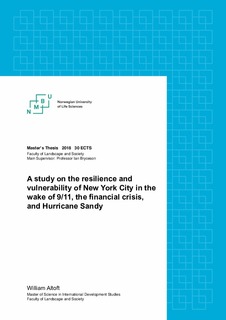| dc.description.abstract | Urbanisation is set to continue rapidly in the 21st century, with a further two and half billion projected to join the urban population by mid-century. Since the founding of a trading port at the tip of Manhattan, New York City has grown through self-organisation from the bottom-up, met forcefully by the top-down implementation of the 1811 grid, and has spread to the surrounding boroughs to become the urban example that led the twentieth century. In the first two decades of the 21st century, it has faced extreme tests of its resilience and vulnerability, with the terrorist attacks of September 11th, 2001, the financial crisis born of the Wall Street crash in 2007, and the climatological hazard of Hurricane Sandy in 2012. The theory of social-ecological resilience was developed to explore complex, adaptive systems, and their capability to deal with shock and surprise, originally within the context of ecosystems in the natural world. Studies of cities have taken on this theory, and now talk of urban resilience, with policy by both city governments and various organisations informed by and acting upon it – yet much of this is limited to dealing with threats from the natural world, which is only one of the many hazards a city faces. The City of New York produced literature and policy purporting to rely on resilience to move forward in the wake of Sandy, and this is reviewed in order to explore what the city means by resilience, and if it has learnt from the effects of the hurricane. Models from resilience and vulnerability theory are then utilised to analyse the events before, during, and after the September 11th attacks and the financial crisis of 2007/08, to explore the city’s resilience, or lack thereof, in areas beside the climate. Though the city is adapting to the prospect of floods and storms, its financial system remains as vulnerable as before, having learnt little after being rescued from the crash of 2007. In the face of unexpected violence in the autumn of 2001, the city demonstrated remarkable resilience in disaster response, the emergency services, infrastructure, and general recovery and rebuilding. However, the New York and American psyche proved vulnerable, and the lasting effect of 9/11 was not in physical destruction, but a cultural, societal trauma. The legacy of the 1811 grid – a much more significant disturbance – is not clear, but it seems to be a fundamental limit to the city’s future options for adaptability and transformability. Despite coming through these early crises of the new century, and though its pride in its resilience has in many areas been earned, New York City has shown some important vulnerabilities in the face of what has been, and what may come. | nb_NO |

